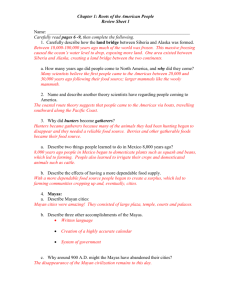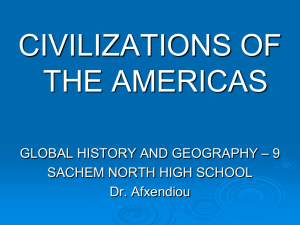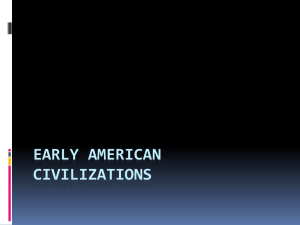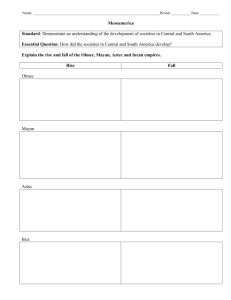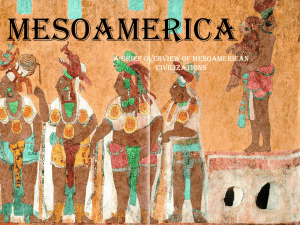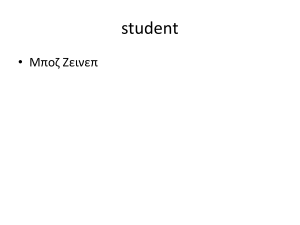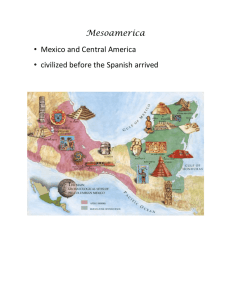America PPT
advertisement
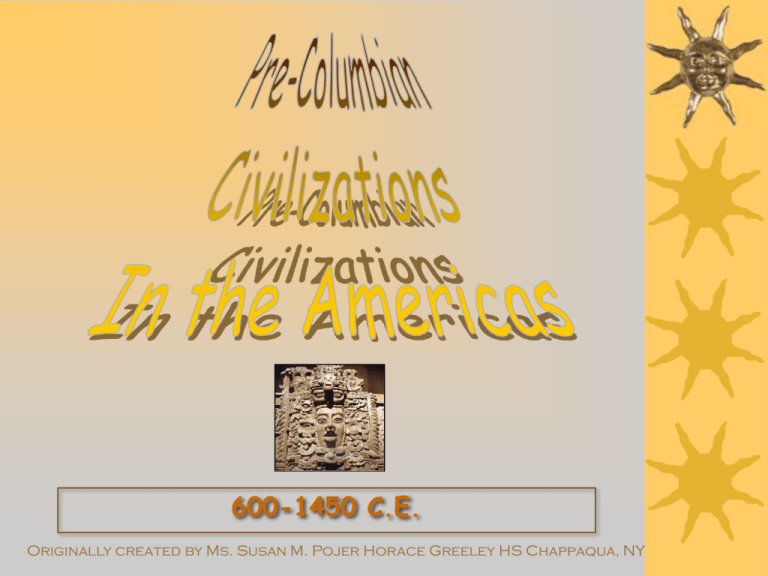
600-1450 C.E. Originally created by Ms. Susan M. Pojer Horace Greeley HS Chappaqua, NY Pre-Colombian Societies Mesoamerica – Teotihuacan – Maya – Toltecs – Aztecs Northern Peoples – Southwest Desert Cultures – Mound Builders- The Mississippi Culture Andean Civilizations – Moche, Paracas, Nazca – Inca Major Pre-Columbian Civilizations Classic-Era Culture of Mesoamerica 600 - 900 C.E. Lands of the Mayans The Yucatan Peninsula Chichen-Itza Chichen-Itza - Observatory Chichen-Itza - Ball Court Mayan Cultivation of Maize Chac, God of Rain -> Mayan Underground Granaries: Chultunes Overview of Tikal (Guatemala) Temple of the Masks Tikal Jungle View at Sunset Tikal - Main Court Tikal: Temple of the Masks Tikal - Wall Mask of the Rain God Mayan Glyphs sky king house child Mayan Mathematics city Mayan Glyphs Mayan Drinking Cup for Chocolate Mayan Warfare The Mayan Kingdoms fought constantly with each other. Typically, the victors destroyed the peoples they defeated. Warriors won prestige when they brought back important captives from neighboring kingdoms. Ultimately, most captives would spend their lives as slaves or sacrificial victims to the Mayan gods. Between the ninth and eleventh centuries C.E., Chichen Itza organized a loose empire that brought a measure of political stability to the northern Yucatan. Mayan Society and Religion Apart from the kings and ruling families, Mayan society included a large class of priests, who maintained an elaborate calendar, knowledge of writing, astronomy, and mathematics. Like many other early civilizations, specialization of labor helped to establish distinct social classes. Peasants and slaves fed the entire society and provided physical labor for the construction of cities and monuments. Quetzalcoatl: The God of Wisdom & Learning Maya Between 800 -900 C.E. cities abandoned Why? – Trade disrupted – Tropical agriculture – Slash and burn Religious, genealogies, Historical events No wheel, pulleys, beasts of burden Patrilineal but traces of women rulers Mayan Calendar – Ritual calendar – Solar Calendar Maya cosmos – Heaven, earthly existence, dark underworld – December 23, 2012? Teotihuacan Expanding human populations led to congregations of people in cities and to the emergence of what is believed to be the largest city in the Americas. At its high point, about 400 to 600 C.E., Teotihuacan was home to almost 200,000 inhabitants, a thriving metropolis with scores of temples, several palatial residences, busy markets, and hundreds of workshops for artisans and craftsmen. Like the later Maya, the residents of Teotihuacan built on the cultural foundations of the Olmec. They played the ball game, adopted the Olmec calendar, and expanded the Olmec’s system of writing. Teotihuacan Teotihuacan Religious architecture Sun, Moon, and 20 smaller pyramids Human sacrifice was performed? Floating Gardens No evidence of single rulers Collapse of Teotihuacan is unknown Conflict, HEI, Class conflict C. 650 C.E. Post-classic Period in Mesoamerica 900-1500 C.E. Toltecs c. 800-1000 Possible satellite population Borrowed heavily from Teotihuacan given credit for all great Mesoamerican achievements First conquest state Established Tula around 968 C.E. Art more warlike and violent character Two chieftains or kings ruled the Toltec state Around 1156 C.E. northern invaders overcame Tula Toltecs influenced the later Mexica or Aztec culture Toltec Capital, Tula “Toltec” means artisan Tula- Pyramid Impact of Maya and Aztec? Lands of the Aztecs Mexica or Aztecs Arrived after collapse of Tula Served as serfs and mercenaries Population grew as did power 1325 C.E. began construction Capitals – Tenochtitlan and Tlatelolco Military success leads to lakeshore gains Introduced Monarchial system Aristocrats selected rulers Military expansion leads to stratification of society Leaders legitimated their rule through rituals Populations of urban areas over 150,000 Tribute payments were common- 1/4 was food 1500 C.e.- Capital and surrounding areas 500,000 Aztec View of Tenochtitlan Modern Mexico City Ruins of the City Center, Tenochtitlan Three Plazas Aztec Spanish Mexican The Codex Mendoza : The Founding of Tenochtitlan Tenochtitlan: The “Venice” of the Americas Aztec Chinampa or Floating Garden: 15 ft. to 30 ft. wide Tenochtitlan - Chinampas Aztec Writing Aztec Math Aztec Sun Stone -- Calendar Aztec Sun Motifs Aztec Codex (15c Manuscript) The Aztecs Were Fierce Warriors Aztecs Sacrifice Neighboring Tribes to the Sun God Heart Sacrifice on an Aztec Temple Pyramid Wall of Skulls, Tenochtitlan Sacrificial Statue? Tenochtitlan Aztec Gold Moche c. 100-800 C.E. Dominated north of Peru Cultural distinction No unified political structure Irrigation of crops – Maize, beans, manioc – Coca for ceremonies Theocratic society Gold / Graves robbed by Spanish All weaved Canals led to decline No political leader? The Moche aka Chimu/Chimor Chan Chan c. 850 Lost legacy? Contemporary to the IcaNazca to the south El Nino? The Moche (Chimor) Lands of the Incas Cultural Links Chavin Paracas Ica-Nazca Moche (Chimor) Cuzco Inca Kingdom of Cusco 1197-1438 Kingdom of Cusco (sometimes spelled Cuzco and in Quechua Qosqo or Qusqu) was a small kingdom in the Andes that began as a small city-state founded by the Incas around the 12th century. In time, through either warfare or peaceful assimilation, it began to grow and was succeeded by the Inca Empire Kingdom of Cusco 1197-1438 The Inca began as a tribe in the Cuzco area around the 12th century under the leadership of Manco Cápac they formed the small city-state of Cusco In time, Cusco would become the center of the Inca Empire Inca Empire 1438-1533 In 1438, under the command of the Sapa Inca (paramount leader) Pachacuti (world-shaker), the Incas began a far-reaching expansion into neighboring lands. The land which Pachacuti conquered was about the size of the Thirteen Colonies at the outbreak of the American Revolution of 1776, and consisted of nearly the entire territory of the Andes mountain range Inca Empire 1438-1533 100 year old empire Multiethnic Empire 200,000 soldiers Pachacuti r. 1438-1463 Reorganized the kingdom of Cusco into an empire Federalist system that consisted of a central government with the Inca at its head and four provincial governments with strong leaders Pachacuti is thought to have built the citadel of Machu Picchu, either as a family home or as a vacation estate Machu Picchu c. 1450 Celestial Location Sacred Space Vacation Home? Machu Picchu See Him? Viracocha Universe Sun Moon Stars Civilization The Inca c.1438-1533 Land of the Four Corners By 1525, 6 million plus-> Pizarro 1526 2,000 miles along Andes and pacific Centered in Cuzco Chiefdom based on tribute Conquered peoples helped economy Pastoralists both men & women Lake Titicaca to Amazon to Pacific Quechua still spoken Cuzco: Ancient Capital of the Inca (11,000 ft. above sea level) Inca Roads Inca Social Structure On top was the Sapa Inca, or the emperor Then came the nobles, these were often the priests and relatives of past emperors or the current ones. After, there were craftsmen and architects. they were very high on the social ladder because of the skill that they had was required by the Empire for such buildings. Then came the working class, often just farmers that were kept in their social groupings. After this, were the slaves and peasants of the society Incan Suspension Bridges Incan Terrace Farming Sacsayhuman Cusco Inca Trail Incan Digging Sticks Quinoa Ollantaytambo granaries Maize in Incan Pottery & Gold Work Over 100 Different Types of Potatoes Cultivated by the Incans Produce from a Typical Incan Market Incan Ceramic Jars Peanut Cacao God Potato Cacao Pod Squash The Quipu: An Incan Database Language? Incan Mummies Inca Gold & Silver Poor timing…1532 100 year old empire Why weren’t they able to stop Pisaro? Northern Peoples 900-1500 C.E. Southwest Desert Cultures Hohokam of the Salt and Gila River Valleys – Strongest Mexican influence – Ball courts, platform mounds, pottery By 1000 - elaborate irrigation system Hisatsinom (Anasazi)-“Ancient Ones” emerge in four corners By 600-well established economy based on: – Maize, beans, and squash Geometrical pottery designs By 900 C.E.- large multistory residential and ritual centers Chaco Canyon, Mesa Verde, Kiet Siel, & Canyon de Chelley Chaco Canyon Northwestern New Mexico Eight large towns built in canyon Approximately 15,000 Multilevel residences Social life and crafts activities Gender roles more egalitarian Modern-day Pueblos Chaco canyon -Kiva Southwest Desert Cultures Anasazi Hohokam Mongollon Hisatsinom (Anasazi) Dwellings Hisatsinom (Anasazi) Art Mesa Verde Mound BuildersMississippian Culture In North America, the first developed towns in the Mississippi Valley would not appear until around 700 C.E. with the largest of these at Cahokia near modern-day St. Louis. Cahokia held a population of 20,000 and perhaps 40,000 lived in the region. A strong central authority existed and stratification of society but no written records remain. Sun worship? Cahokia Mound Builders NY to IL Ontario to FL 700-1500 C.E. Hunting, gathering Cultivation Contacts w/ Mesoamerica? Chiefdom tradition 10,000- hereditary ruler Cahokia - Largest mound 100 ft x 1037 ft x 790 ft 30 m x 316 m x 241 m Mound Builders Canoe-based trade Sea shells, copper Grand tombs Sacrifice of others Military defeat? Deforestation? European arrival… Southern Peoples c. 900 -1500 C.E.
